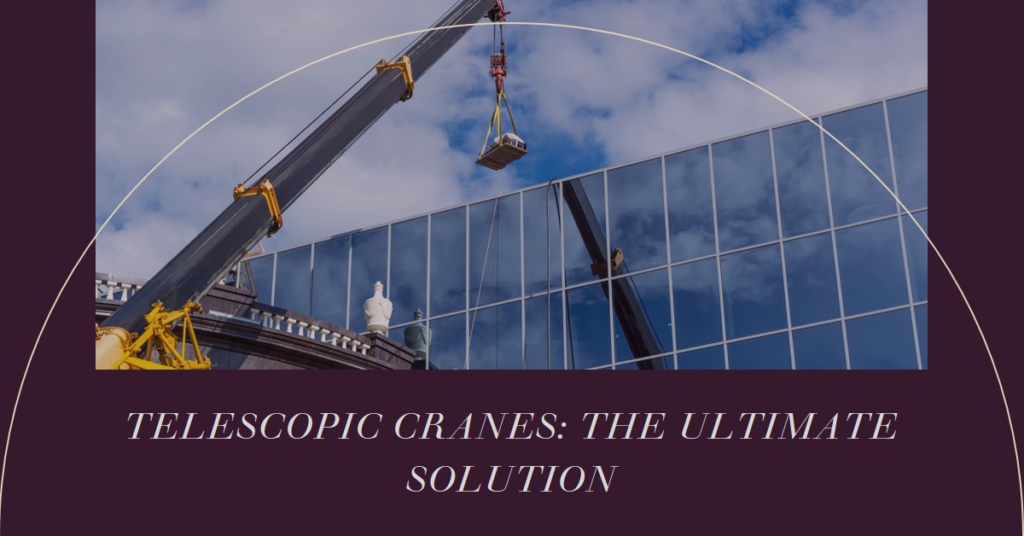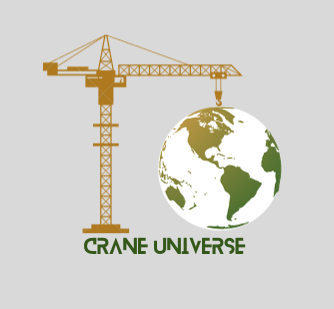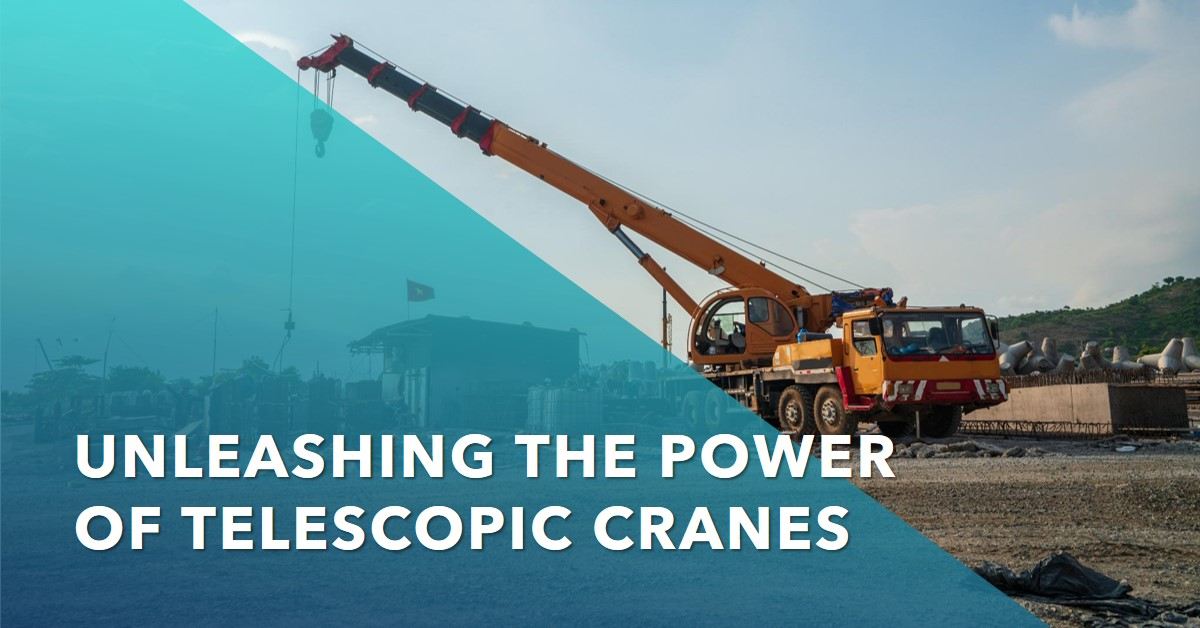Table of Contents
In the bustling world of construction and heavy lifting, few machines command the awe and respect that telescopic cranes do. These towering giants, with their ability to reach seemingly impossible heights and distances, have revolutionized the way we build, transport, and handle heavy loads. From towering skyscrapers to sprawling bridges and bustling industrial sites, telescopic cranes have left an indelible mark on various industries, becoming indispensable assets in the process. In this comprehensive guide, we’ll embark on a journey into the fascinating world of telescopic cranes, exploring their intricate mechanics, diverse applications, compelling benefits, and everything else you need to know to understand their significance and potential. So, fasten your seatbelts and prepare to delve deep into the realm of telescopic cranes.

Understanding Telescopic Cranes
Telescopic cranes, often referred to as boom cranes or hydraulic cranes, represent a marvel of engineering ingenuity in the realm of heavy lifting. At their core, these cranes are characterized by a telescoping boom, a feature that sets them apart from other crane types. This telescopic mechanism enables the boom to extend and retract, offering unparalleled reach and versatility in lifting operations. Picture it like a telescope: just as you can adjust the length of a telescope to zoom in or out, a telescopic crane’s boom can be extended or retracted to adjust its reach and lifting capacity. This remarkable flexibility makes telescopic cranes incredibly adaptable to various job site requirements, allowing operators to tackle a wide range of lifting tasks with precision and efficiency.
The boom itself is typically composed of multiple sections, often referred to as “telescopes,” which can be hydraulically extended or retracted to achieve the desired length. This modular design not only enhances the crane’s lifting capabilities but also facilitates ease of transportation and maneuverability on the job site. So, whether you’re lifting heavy materials to towering heights or navigating through tight spaces, a telescopic crane’s telescoping boom is your ticket to unmatched versatility and performance.
The Mechanics Behind Telescopic Cranes
At the core of every telescopic crane resides a sophisticated network of hydraulic components that work in perfect harmony to power its telescoping boom. Picture it as the beating heart of the crane, driving its movements and lifting capabilities with precision and efficiency. Now, let’s break down this intricate system and understand how it operates.
First and foremost, we have hydraulic cylinders, the powerhouse behind the crane’s telescopic action. These cylinders act as the muscles of the crane, expanding and contracting in response to hydraulic pressure. When the operator activates the crane’s controls, hydraulic fluid is pumped into these cylinders, exerting force and causing them to extend or retract. It’s this controlled expansion and contraction of the cylinders that enable the telescopic boom to adjust its length, reaching outwards to lift heavy loads or retracting inward for compact storage and transportation.
But what drives this hydraulic system? Enter hydraulic pumps and valves, the unsung heroes of the crane’s hydraulic operation. These components work together to regulate the flow of hydraulic fluid, directing it to the cylinders to initiate movement. The hydraulic pump acts as the heart of the system, drawing in hydraulic fluid and pressurizing it before sending it to the cylinders. Meanwhile, hydraulic valves serve as the gatekeepers, controlling the flow of fluid to different parts of the system to ensure smooth and precise operation.
So, when the operator activates the controls, it sets off a carefully choreographed dance of hydraulic fluid, cylinders, pumps, and valves. Hydraulic fluid is pumped into the cylinders, causing them to extend or retract, while valves regulate the flow to ensure controlled movement. The result? The telescopic boom of the crane gracefully extends outward or retracts inward, adjusting its reach and lifting capabilities with remarkable ease and precision.
In essence, it’s this ingenious hydraulic system that gives telescopic cranes their unmatched flexibility and efficiency in lifting operations. Whether it’s reaching towering heights on a construction site or navigating tight spaces in an industrial facility, the mechanics behind telescopic cranes ensure that they rise to the occasion with unparalleled performance and reliability.
Applications of Telescopic Cranes
Telescopic cranes are the workhorses of numerous industries, offering unmatched versatility and lifting power across a wide spectrum of applications. Let’s dive deeper into the various ways these remarkable machines are utilized:
- Construction: Telescopic cranes are indispensable on construction sites, where they take on a multitude of tasks with ease. Whether it’s hoisting steel beams into place, lifting heavy construction materials to upper levels of buildings, or maneuvering prefabricated components with precision, these cranes are essential for keeping construction projects moving forward safely and efficiently.
- Infrastructure Development: When it comes to building bridges, highways, and other critical infrastructure, telescopic cranes are at the forefront. Their ability to lift and position heavy structural elements with pinpoint accuracy makes them invaluable assets in infrastructure projects. Whether it’s placing massive concrete segments for bridge construction or handling heavy machinery for highway maintenance, telescopic cranes ensure that infrastructure projects proceed smoothly and on schedule.
- Shipping and Logistics: Ports and harbors rely heavily on telescopic cranes for their cargo handling needs. These cranes excel at loading and unloading cargo from ships, containers, and freight trains, facilitating the seamless flow of goods through the supply chain. From lifting containers off ships to transferring heavy machinery onto trucks, telescopic cranes play a pivotal role in streamlining shipping and logistics operations, ensuring that goods are moved efficiently from one destination to another.
- Oil and Gas Industry: In the oil and gas sector, telescopic cranes are instrumental in supporting drilling operations, pipeline construction, and offshore installations. These cranes are used to lift heavy equipment, pipes, and other materials onto drilling rigs and platforms, enabling the extraction and transportation of oil and gas resources safely and efficiently.
- Emergency Response: Telescopic cranes are also deployed in emergency response situations, such as during natural disasters or building collapses. These cranes can be used to lift debris, rescue trapped individuals, and assist with recovery efforts, providing crucial support to emergency responders and aiding in the restoration of affected areas.
In essence, the applications of telescopic cranes are as diverse as the industries they serve. From construction and infrastructure development to shipping, logistics, and emergency response, these versatile machines continue to play a vital role in driving progress and innovation across various sectors, lifting heavy loads and lifting spirits alike with their unwavering performance and reliability.
Advantages of Telescopic Cranes
Telescopic cranes offer several advantages that make them a preferred choice for many lifting applications:

Reach and Versatility
Telescopic cranes are real superheroes in the world of heavy lifting, and they’ve got two amazing superpowers: outstanding reach and incredible versatility. Imagine a crane that can stretch its boom to towering heights, effortlessly reaching over obstacles and getting into those tight spots where other cranes just can’t go. That’s the magic of telescopic cranes—they’re like the superheroes of the construction site, swooping in to save the day when heavy materials need to be lifted to great heights or when machinery needs a helping hand in hard-to-reach corners.
But their awesomeness doesn’t stop there. Telescopic cranes can also stretch out horizontally, covering huge areas without needing to move around. So whether it’s a bustling construction site, a sprawling warehouse, or a busy port, these cranes are always up for the job, making lifting tasks look like a piece of cake. They’re the ultimate problem-solvers, helping operators tackle tricky lifting jobs with ease and efficiency, no matter the challenges they face.
Mobility and Maneuverability
Telescopic cranes as the nimble ninjas of the construction world, darting through city streets and conquering rugged landscapes with ease. Unlike their bulky counterparts, these cranes are designed to be mobile and maneuverable, able to zip from one job site to another without breaking a sweat. Their compact size and agile nature make them the ultimate problem-solvers, squeezing into tight spaces and reaching remote locations with ease. Whether it’s navigating through bustling city streets or tackling rough terrain in the great outdoors, telescopic cranes are always up for the challenge, bringing their unmatched versatility wherever they go.
But their mobility isn’t just about getting from point A to point B—it’s also about how effortlessly they can adapt to different environments. With their flexible design and nimble movements, telescopic cranes can weave through crowded construction sites or scale rugged landscapes with grace, making them the go-to choice for projects where space is limited or access is tricky. So, whether it’s lifting heavy loads in the heart of the city or reaching new heights in the wilderness, telescopic cranes are the ultimate companions, ready to tackle any task with finesse and precision.
Quick Setup and Deployment
Telescopic cranes are engineered with efficiency in mind, offering rapid setup and deployment capabilities that enable operators to initiate lifting operations swiftly. Unlike other crane types that may involve complex assembly processes, telescopic cranes boast a streamlined design with fewer components to assemble and disassemble. This simplified setup procedure translates into significant time-saving benefits, reducing downtime and enhancing productivity on the job site.
With telescopic cranes, operators can quickly mobilize and commence lifting tasks without prolonged delays, thereby optimizing workflow and facilitating seamless project execution. Whether it’s a construction site, infrastructure project, or industrial facility, the swift setup and deployment of telescopic cranes contribute to overall operational efficiency and project success.
Considerations When Using Telescopic Cranes
While telescopic cranes offer numerous advantages, there are also important considerations to keep in mind to ensure safe and efficient operation:
Load Capacity and Stability
When it comes to operating telescopic cranes, one of the golden rules is to always respect the crane’s load capacity and stability guidelines. Ignoring these limits can have serious consequences, including accidents, injuries, and damage to equipment. Overloading the crane puts immense strain on its components and compromises its stability, increasing the risk of tipping over or collapsing. Additionally, operating on unstable ground further exacerbates these risks, as it can cause the crane to sink or shift unexpectedly. By adhering to the load capacity limits and ensuring proper stability, operators can significantly reduce the likelihood of accidents and ensure safe lifting operations.
Maintaining awareness of load capacity and stability isn’t just about following rules – it’s about prioritizing safety above all else. Before lifting any load, operators should carefully assess its weight and dimensions to ensure they fall within the crane’s rated capacity. It’s also essential to consider factors like the ground condition and terrain slope, as these can affect the crane’s stability during lifting operations. By taking these precautions and erring on the side of caution, operators can protect themselves, their colleagues, and the surrounding environment from potential harm. Remember, when it comes to telescopic cranes, safety always comes first.
Environmental Conditions
When operating telescopic cranes, it’s essential to be mindful of the environmental conditions that can impact their safe operation. Factors like wind speed, weather conditions, and ground stability all play crucial roles in determining the crane’s stability and performance. For instance, strong winds can exert lateral forces on the crane’s boom, causing it to sway or lose balance, while adverse weather conditions like rain or snow can affect visibility and create slippery surfaces. Additionally, ground stability is paramount, as uneven terrain or soft ground can compromise the crane’s stability and pose safety risks during lifting operations. Operators must carefully assess these environmental factors before commencing any lifting activities and take appropriate precautions to ensure safe operation.
To mitigate the risks associated with environmental conditions, operators should adopt proactive measures and adhere to strict safety protocols. This includes regularly monitoring weather forecasts and wind speeds to anticipate any adverse conditions that could affect crane operations. When adverse weather is forecasted or when operating in challenging terrain, it’s crucial to adjust lifting operations accordingly or even postpone them if conditions pose an imminent risk. Furthermore, ensuring proper ground preparation, such as leveling the ground and using outriggers or stabilizers, can enhance the crane’s stability and reduce the likelihood of accidents. By staying vigilant and responsive to changing environmental conditions, operators can maintain safe working conditions and minimize the risk of accidents or incidents on the job site.
Operator Training and Certification
Ensuring that crane operators receive proper training and certification is paramount for the safe and effective operation of telescopic cranes. These machines demand specialized skills and knowledge to maneuver them safely, considering their intricate hydraulic systems and the risks involved in lifting heavy loads. Comprehensive training programs cover various aspects of crane operation, including understanding the crane’s controls, conducting pre-operation inspections, and executing lifting procedures safely. By undergoing such training, operators gain the expertise needed to handle the crane confidently and mitigate potential hazards on the job site.
Moreover, obtaining the necessary certifications serves as validation of an operator’s competence and proficiency in operating telescopic cranes. Certification programs typically involve theoretical and practical assessments to ensure that operators possess the requisite knowledge and skills to operate the crane safely. Regular refresher courses are also essential to keep operators updated on industry best practices, safety regulations, and technological advancements in crane operation. By investing in ongoing training and certification, companies demonstrate their commitment to safety and ensure that their crane operators are equipped to handle the demands of the job effectively.
Conclusion
In conclusion, telescopic cranes stand as marvels of engineering ingenuity, embodying the fusion of innovation and utility. Their exceptional capabilities empower industries across the globe, facilitating the completion of complex projects with precision and efficiency. By delving into the mechanics, applications, and considerations surrounding telescopic cranes, operators gain valuable insights that enhance their ability to harness these machines effectively. Whether lifting heavy loads amidst bustling construction sites or navigating through challenging terrains, telescopic cranes serve as reliable companions in achieving ambitious goals while upholding safety standards.
In essence, telescopic cranes epitomize the spirit of progress, enabling humanity to reach new heights and conquer formidable challenges. As we continue to embrace technological advancements and refine our understanding of these remarkable machines, the future holds boundless possibilities for innovation and growth. With telescopic cranes at the forefront of our endeavors, we embark on a journey toward greater efficiency, safety, and success in lifting operations across diverse industries.


of course like your website but you have to check the spelling on several of your posts A number of them are rife with spelling issues and I in finding it very troublesome to inform the reality on the other hand I will certainly come back again
Ya sure!!
Thank you!!
I simply could not go away your web site prior to suggesting that I really enjoyed the standard info a person supply on your guests Is going to be back incessantly to investigate crosscheck new posts
Thank you!!
Somebody essentially help to make significantly articles Id state This is the first time I frequented your web page and up to now I surprised with the research you made to make this actual post incredible Fantastic job
helloI like your writing very so much proportion we keep up a correspondence extra approximately your post on AOL I need an expert in this space to unravel my problem May be that is you Taking a look forward to see you